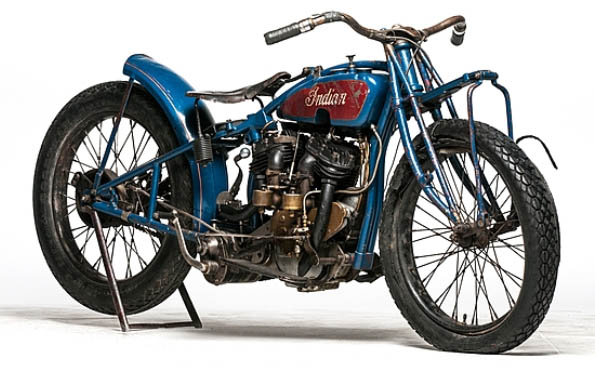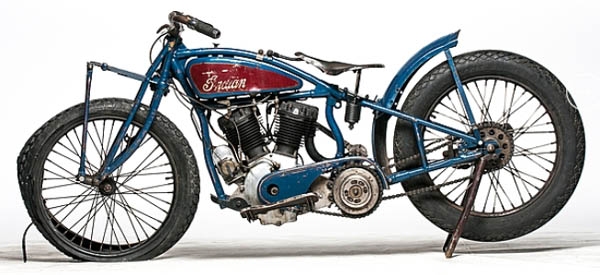The Best of of the EJ Cole Motorcycle AuctionMarch 20-21, 2015 - Las Vegas, Nevada |
Sold for $225,000 on March 21, 2015 The new 61 cu-in. sidevalve racer, designed by Charles Franklin, was a totally new engine, although in board track configuration it used the same chassis as the 1920 factory machines. Internally, the timing gears and crankshaft were carried in self-aligning ball bearings, and there were two oil pumps. The most distinctive features of the Altoona were the removable cylinder heads – a first for any SV Indian – and twin updraft Zenith racing carbs. Using two carburetors for a twin-cylinder engine was rare enough in those early days, and Indian went further still by mounting it in the best possible configuration: as the valves fed the cylinder from below, mounting the carburetor barrel in a straight vertical shot was the equivalent of a modern downdraught carb and the recipe for the best possible gas flow. The combustion chamber was shaped by the theories of Harry Ricardo for the highest compression and most efficient burn. The Altoona proved to be the fastest sidevalve engine Indian ever built, and the fastest sidevalve engine period, until Tom Sifton spent serious time developing the Harley-Davidson KRTT. |
| 1928 INDIAN ALTOONA HILLCLIMBER | |
|
How fast was the Altoona? On July 9, 1926,
‘Curley’ Fredericks lapped Altoona at 114 MPH in a race – the highest
speed ever recorded on a circular track, and the racer was immediately
dubbed the ‘Altoona.’ On August 21st at Rockingham, New Hampshire, on a
1.25-mile board track, Fredericks won both 61 cu-in. events, and on one
lap recorded a time of 37.25 seconds, which translates to 120.3 MPH, the
fastest speed ever recorded on a board track. On September 18th on the
same track, Fredericks averaged 114.1 MPH over a five-mile race. It was
clear the end was near for board track racing, and the Altoona’s speed
was never bettered as the sport vanished soon after. With such a powerful engine, it was natural to employ the Altoona in other racing venues, including hillclimbing. The Altoona was victorious in many National Championship hillclimbs as well, as the alcohol-burning, fire-breathing monsters proved adaptable even for ‘vertical drag racing.’ This 1928 Indian Altoona hillclimber, serial #A61-83, is an original machine in as-raced condition and a truly legendary powerhouse from Indian, with a board track speed record which will never be broken. |


